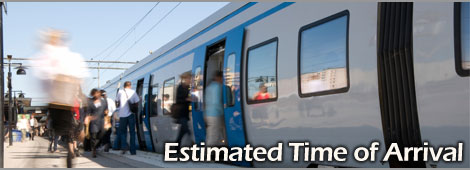What is the full form of ETAETA: Estimated Time of ArrivalETA stands for Estimated Time of Arrival. It is also called the Expected Time of Arrival. ETA is one of the popular internet slangs now a day. It is used to show the amount of time remaining for a particular entity to arrive or something is expected to be done. This entity can be a train, aeroplane, bus, ship, letter, courier anything that you expect to arrive. This term is commonly used to show the date the time at which a ship is supposed to arrive at the port. The time is specified in the form of a particular date with expected time in hours and minutes. The Expected time is measured from past experiences and with the help of a formula. For example, in public transport, the estimated time of arrival of trains, buses, planes etc., is calculated on the basis of their static timetable, traffic intensity and current and past record of movements. 
Let's take an example to understand it well: Suppose you are travelling from Delhi to Agra by train. The distance between Delhi to Agra is 180 km, and the average speed of the train is 60 km/hour. So if you start your journey at 6 am, your estimated time of arrival (ETA) at Agra will be 9 am. This is the formula to calculate the ETA: ETA-Related FactorsThere are several variables that impact ETA, and they may be generally divided into two groups: internal variables and external variables. Internal ElementsInternal factors are those that the person or the vehicle can control. These variables include the vehicle's speed, the distance to be travelled, and any pauses or detours that are anticipated. Speed: A significant element affecting ETA is the speed at which a vehicle is moving. The sooner the car gets to its target, the faster it will be moving. In contrast, it will take longer for a vehicle to get to its destination if it moves more slowly. Distance: Another significant element affecting ETA is the required travel distance. The journey will take longer the further away the location is. In contrast, a vehicle will arrive at its destination more quickly the closer the distance. Planned stops or diversions will have an impact on the estimated time of arrival (ETA). The amount of time needed to get there will increase with each stop or detour. External variablesExternal factors are those over which the individual or the vehicle has no control. These variables include the volume of traffic, the climate, the state of the roads or the rails, and other possible delays. Traffic conditions: ETA is significantly impacted by traffic conditions. The time it takes the car to get where it's going will increase if there is heavy traffic. On the other hand, if there is less traffic, the car will get there faster. Weather: ETA might be impacted by the weather. The time it takes to get there may increase if the weather is poor, such as when there is heavy rain, snow, or fog. The vehicle may also need to slow down or take a different route. Road or rail conditions: ETA is also impacted by the state of the road or rail. The vehicle might need to slow down if the road or rail is in bad condition, which could extend the travel duration. ETA applicationsApplications for ETA may be found in a number of industries, including transportation, logistics, and emergency services. Transportation: ETA is widely used in many modes of travel, including vehicles like automobiles, buses, trains, and aeroplanes. Using ETA, travellers may plan their journeys and guarantee that they arrive at their destinations on time. Logistics: The movement of commodities from one location to another is planned using ETA. This aids businesses with inventory management and on-time delivery of their products. Emergency services, including ambulance services, fire agencies, and police departments, employ ETA. They utilise ETA to react swiftly to crises and to make sure they get to the site as rapidly as feasible. ETA's limitationsETA is a projection based on several variables, and it has some restrictions. These restrictions include, among others: Unexpected delays: unexpected delays, such as traffic jams or road closures, can greatly extend the travel time and are not taken into consideration by ETA. Inaccurate information: ETA is based on a variety of data sources, including traffic and meteorological information. The ETA will also be erroneous if the data is incorrect. Human error: Inaccurate data entry or faulty assumptions might have an impact on ETA predictions. ConclusionSince everyone wants to know when they will arrive at their location in today's fast-paced environment, ETA is an essential tool. It is determined using a number of variables, such as distance, speed, traffic, weather, and other potential delays. ETA has a number of uses in the transportation, logistics, and emergency services sectors. However, it has several drawbacks, such as unanticipated delays, erroneous data, and human mistakes. Despite these drawbacks, ETA continues to be a useful resource that aids travellers in trip planning and on-time arrival at their destinations.
Next TopicFull Form
|
 For Videos Join Our Youtube Channel: Join Now
For Videos Join Our Youtube Channel: Join Now
Feedback
- Send your Feedback to [email protected]
Help Others, Please Share










